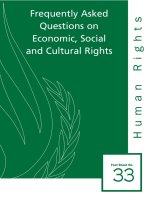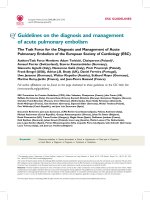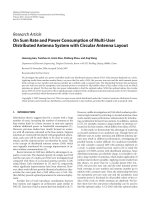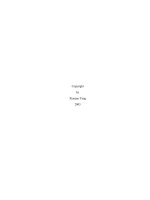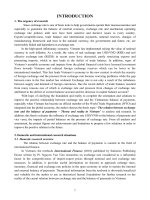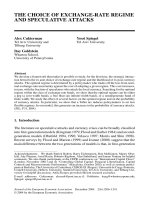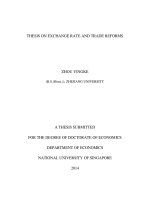Thesis on exchange rate and trade reforms
Bạn đang xem bản rút gọn của tài liệu. Xem và tải ngay bản đầy đủ của tài liệu tại đây (1.45 MB, 149 trang )
THESIS ON EXCHANGE RATE AND TRADE REFORMS
ZHOU YINGKE
(B.S.(Hons.)), ZHEJIANG UNIVERSITY
A THESIS SUBMITTED
FOR THE DEGREE OF DOCTORATE OF ECONOMICS
DEPARTMENT OF ECONOMICS
NATIONAL UNIVERSITY OF SINGAPORE
2014
i
DECLARATION
I hereby declare that this thesis is my original work and it has been written by
me in its entirety. I have duly acknowledged all the sources of information
which have been used in the thesis.
This thesis has also not been submitted for any degree in any university
previously.
Zhou Yingke
August 16 2014
ii
ACKNOWLEDGEMENTS
I would like to take this opportunity to show my gratitude toward people that
have kindly helped and supported me along this long but fulfilling road.
Firstly, I am indebted to my supervisor, Assoc. Prof. Lu Yi, for his
excellent guidance and deep knowledge in applied econometrics. It would not
have been possible for me to complete my thesis without his support and
collaboration. His unparalleled passion and dedication in academic works do
inspire me to work harder. I would like to express my heartfelt gratitude to
him. It is my honor to be under his supervision.
Secondly, I would like to thank Assoc. Prof. Davin Chor, and Hu Albert
Guangzhou, for their constructive comments and suggestions on my thesis. I
am particularly grateful to Dr. Hsu Wen-Tai, Liu Qing, and Sng Tuan-Hwee,
who collaborate with me on the paper version of thesis. Moreover, I would
like to thank Prof. Kim Sun Bae, Tao Zhigang, Zhang Jie, Assoc. Prof. Tilak
Abeysinghe, Chang Tou Chuang, Zeng Jingli, Dr. Chen Xiaoping, Gong Jie,
Wang Yong, Mr. Ngiam Tong Yuen, for their help and suggestions during my
study at NUS.
Thirdly, I want to express my deep gratitude to my Ph.D colleagues.
Thanks Liu Zhengning, Lu Yunfeng, Xie Huihua, Zhu Lianming, and others
for all the inspirational conversations and debates. In addition, special thanks
to Shen Bo, and Liu Xuyuan, for your kind, sincere and unselfish help.
Finally, I would like to dedicate this thesis to my parents, my wife Fan
Jiaxing, and parents-in-law. Their love and support have accompanied me
along the journey and helped me get close to my dream.
iii
Table of Contents
DECLARATION i
ACKNOWLEDGEMENTS ii
Table of Contents iii
Summary vi
List of Figures viii
List of Tables ix
Chapter One 1
Do Exports Respond to Exchange Rate Changes? Inference from China’s
Exchange Rate Reform 1
1.1 Introduction 1
1.2 Estimation Strategy 5
1.2.1 Data 5
1.2.2 China’s Exchange Rate Reform in July 2005 7
1.2.3 Estimation Specification 10
1.3 Empirical Findings 13
1.3.1 Graphical Presentation 13
1.3.2 Main Results 15
1.3.3 Robustness Checks 16
1.3.4 Exchange Rate Elasticity 20
1.3.5 Trade Diversion 21
1.3.6 Mechanism 22
1.3.7 Heterogeneous Effects 24
1.4 Conclusion 26
Chapter Two 28
Exchange Rates and Export Structure 28
2.1 Introduction 28
2.2 A Model of Exchange Rate and Export Structure 32
2.2.1 Model Setup 32
2.2.2 Equilibrium and the Effect of the Exchange Rate 35
iv
2.2.3 Export Structure and the Exchange Rate 37
2.2.4 Developed Countries Export Relatively More Goods with Low
Elasticity of Substitution 40
2.3 Estimation Strategy 41
2.3.1 Data and Variables 41
2.3.2 China’s Exchange-Rate Reform in July 2005 44
2.3.3 Estimation Framework 46
2.4 Empirical Findings 49
2.4.1 Main Results 49
2.4.2 Robustness Checks 50
2.4.3 Decomposition of the Effect of Currency Appreciation 52
2.5 Conclusion 54
Chapter Three 55
When Trade Discourages Political Favoritism: Evidence from China 55
3.1 Introduction 55
3.2 Estimation Strategy 60
3.2.1 China’s WTO Accession 60
3.2.2 Data 63
3.2.3 Estimation Specification 65
3.3 Empirical Findings 70
3.3.1 Magnitude and Gains Calculation 71
3.3.2 Robustness Checks 72
3.4 Mechanism 75
3.4.1 Import Competition, Export Market Access, Import Inputs 75
3.4.2 Intra-vs. Inter-Industry Reallocation 77
3.4.3 Extensive-vs. Intensive Margins 78
3.4.4 Heterogeneous Response of SOEs 81
3.5 Conclusion 84
Figures and Tables for Chapter One 87
Figures and Tables for Chapter Two 97
Figures and Tables for Chapter Three 101
Bibliography 115
1. Chapter One 115
2. Chapter Two 119
v
3. Chapter Three 122
Appendices 127
Appendix 1 for Chapter One 127
Appendix 2 for Chapter Two 131
Appendix 3 for Chapter Three 139
vi
Summary
This thesis consists of three chapters within the broad field of international
trade. All three essays are self-contained and can be read independently of the
others. They include: (i) Do Exports Respond to Exchange Rate Changes?
Inference from China's Exchange Rate Reform; (ii) Exchange Rates and
Export Structure; and (iii) When Trade Discourages Political Favoritism:
Evidence from China.
The first chapter revisits the exchange rate disconnect puzzle by using
monthly data and exploiting the unexpected exchange rate reform in China as
a natural experiment. The difference-in-differences estimation uncovers a
negative and statistically significant effect of a currency appreciation on
exports: a 1% currency appreciation is found to cause total exports to fall by
1.61%. We find no trade diversion by Chinese exporters after the currency
appreciation, both intensive-margin and extensive margin effects of exchange
rate changes on exports, and heterogeneous effects across regions, firms and
industries/products.
The second chapter studies whether changes in the exchange rate affect a
country’s export structure, using an arguably exogenous sudden appreciation
of renminbi on July 21, 2005 as the main source of identification. Employing
combined regression discontinuity and difference-in-differences approach, we
show that China’s export structure became more similar to that of the
developed countries after the currency appreciation. We also find that the
vii
majority of the appreciation effect comes from the inter-firm resource
reallocation rather than the inter-region or intra-firm resource reallocation.
The last chapter empirically investigates if trade leads to market reallocation
away from politically favored but unproductive firms. This paper finds that
tariff reductions after China’s WTO accession induced a 2.5% percentage-
point decline in the SOE output share and reduced the standard deviation of
firm productivity by 1.4% between 2001 and 2005. The likelihood of SOE exit
was related more to political affiliation than to performance: the SOEs
affiliated with county and township governments were the worst hit, while
those affiliated with higher-level governments were barely affected. Our
results suggest that trade could help reduce inefficiencies arising from the
political economy.
viii
List of Figures
Chapter One
Figure 1.1: The Ratio of Exports in Our Regression Sample over Total
Exports (2000-2006) 87
Figure 1.2: Monthly Nominal RMB Exchange Rate (2000-2006) 88
Figure 1.3: Difference between Exports to U.S. and Exports to Other Non-
U.S. Countries in Our Regression Sample 89
Chapter Two
Figure 2.1: Elasticity of Substitution and PRODY(lowess line) 97
Figure 2.2: Monthly Nominal USD/RMB(2000-2006) 98
Figure 2.3: Ln(Export Similarity Index) 2003 versus 2005 99
Chapter Three
Figure 3.1: Tariffs(1996-2007) 104
Figure 3.2: The Correlation between Tariffs in 2001 and Tariff Changes
during 2001-2005 105
Figure 3.3: Estimated Coefficients from the Flexible DID Estimation 106
ix
List of Tables
Chapter One
Table 1.1: List of Countries 90
Table 1.2: Main Results 91
Table 1.3: Robustness Checks 92
Table 1.4: Exchange Rate Elasticity 93
Table 1.5: Trade Diversion 94
Table 1.6: The Effect of Exchange Rate Reform on Extensive and Intensive
Margins 95
Table 1.7: Heterogeneous Effects 96
Chapter Two
Table 2.1: The Top 5 Sophisticated Goods and the Bottom 5 Sophisticated
Goods(U.S. $2000) 100
Table 2.2: Main Results 101
Table 2.3: Robustness Checks 102
Table 2.4 Decomposition of the Effect of Currency Appreciation 103
Chapter Three
Table 3.1: Main Results 107
Table 3.2: Robustness Checks 108
Table 3.3: Imports, Exports, and Imported Inputs 109
Table 3.4: Intra-vs. Inter-Industry Reallocation 110
Table 3.5: Intensive vs. Extensive Margins, Overall 111
Table 3.6: Intensive vs. Extensive Margins, Regression Results 112
Table 3.7: Differential Exit Rates 113
Table 3.8: Breakdown of SOE Productivity Quantile by Affiliation 114
1
Chapter One
Do Exports Respond to Exchange Rate Changes?
Inference from China’s Exchange Rate Reform
1.1 Introduction
“Japanese exports could be badly hurt by the yen’s recent rapid rise, Mr.
Gaishi Hiraiwa, chairman of the Keidanren, the country's federation of
economic organizations, warned yesterday ” – Financial Times, September
29 1992
1
“In a weekend interview, Finance Minister Guido Mantega stated flatly
that Brazil ‘will not let the real appreciate.’ A strong Brazilian real, Mr.
Mantega said, hurts exports and manufacturers” – The Wall Street Journal,
September 20 2012
2
Government officials and commercial circles across the world are
concerned about the severe consequences of a currency appreciation on
exports and domestic production, as exemplified by the above quotes.
However, academic studies show that the exchange rate movement is largely
disconnected from fundamentals such as exports (this is referred to as the
exchange rate disconnect puzzle. See Obstfeld and Rogoff, 2000).
3
For
example, Dekle, Jeong and Ryoo (2010) find that the elasticity of exports with
respect to the exchange rate is not statistically different from zero for every
1
See "Japanese fear rising yen will hurt exports" by Financial Times
( Access date: October 9 2012
2
See "Brazil Faces Currency Appreciation After Fed Move -Bradesco" by The Wall Street
Journal ( Access date: October 9
2012
3
Papers linking import prices to exchange rates include Goldberg and Knetter (1997) and
Campa and Goldberg (2005, 2010), among others.
2
G-7 country for the period of 1982–1997.
4
The contrasting views between
political/commercial circles and academia present an interesting research
question: do exports respond to exchange rate changes?
Our study contributes to the aforementioned debate by revisiting the
empirical evidence in two new manners. Firstly, in contrast to the yearly data
that are commonly used in the literature, our empirical analysis uses monthly
data, which gives us more variations with which to calculate the effect of
exchange rate changes on exports. Secondly, and more importantly, instead of
resorting to a micro-level analysis (i.e., using firm-destination or
firm-product-destination data) as in some of the recently emerged literature,
5
we stick to the macro-level analysis but explore a natural experiment setting in
China to carefully address the estimation biases due to the endogeneity
associated with exchange rate changes (i.e., omitted variables bias and reverse
causality).
6
Specifically, the Chinese government unexpectedly revalued its
currency against the US dollar on July 21, 2005, which resulted in an
immediate appreciation of 2.1% (for more description of the episode, see
Section 1.3). Such an exogenous shock provides us with an opportunity to
consistently estimate the effect of exchange rate changes on exports by
comparing China’s monthly exports to the U.S. (the treatment group) with
4
See also Kenen and Rodrik (1986), Hooper, Johnson and Marquez (2000), and Colacelli
(2009) for similar findings.
5
See for example, Dekle, Jeong, and Ryoo, (2010); Berman, Martin, and Mayer (2012);
Amiti, Itskhoki and Konings (2014); Chatterjee, Dix-Carneiro, and Vichyanond (2013).
6
Understanding the aggregate-level response is important for both policy and academic
purpose. Firstly, whether total exports respond to exchange rate movement or not is what
concerns policy makers and its answer has implication for other monetary policies like interest
rate, current account management, etc. Secondly, as one of the major puzzles in international
macroeconomics, the small elasticity of export to exchange rate has generated a vast number
of studies to understand the underlying reasons and to evaluate the potential welfare impacts
of related policies (e.g., Duarte, 2003). However, there is still no consensus regarding the
empirical association between exchange rate changes and total exports, due to the prevailing
endogeneity issues.
3
those to other countries (the control group) before and after the currency
revaluation, or a difference-indifferences estimation specification. Meanwhile,
we also control for those potential omitted variables implied by the
micro-level analysis, such as producer dispersion (Dekle, Jeong, and Ryoo,
2010; Berman, Martin, and Mayer, 2012) and import value (Amiti, Itskhoki
and Konings, 2014).
We find a negative and statistically significant effect of a currency
appreciation on exports. In terms of economic magnitude, a 1% currency
appreciation is found to cause total exports to fall by 1.61%. Given that China
exported US$1.904 trillion worth of goods in 2011, a 1% currency
appreciation means a US$30.65 billion decrease in Chinese exports to the
U.S., a significant number, which may justify the concerns by government
officials and exporters. Our estimation results are robust to various checks on
the validity of the DID estimation, including the control for country-specific
month effects and country-specific linear time trend, a check on the
pre-treatment differential trends between the treatment and control groups, a
placebo test using homogeneous goods as the regression sample, and a
difference-in-difference-in-differences (triple difference) estimation.
Meanwhile, we find that the currency appreciation did not lead to trade
diversion to other countries by Chinese exporters, suggesting that the fall in
exports resulted in substantial exits of Chinese exporters from the exporting
market. Moreover, we find the export response to exchange rate changes to be
more prominent in China's coastal regions, among Chinese state-owned
enterprises, within time sensitive industries, and for non-necessities.
4
To understand how exchange rate changes affect exports, we extend the
Melitz and Ottaviano (2008) model to incorporate the role of exchange rate
movements (See the Appendix 1 for details). It is found that the effect of
exchange rate changes on the aggregate export value can be decomposed into
two parts, the intensive and the extensive margins. Specifically, the currency
appreciation increases the final prices of exports in foreign markets as well as
decreases the free on board (FOB) export price due to incomplete
pass-through, which causes FOB export revenues to fall (the intensive-margin
effect). In the meantime, as exporters differ in their production efficiency,
some less productive exporters find that their export profits become negative
and hence choose to exit the foreign markets (the extensive-margin effect). By
exploring our comprehensive data, we find supports for both intensive-margin
and extensive-margin effects, that is, fewer firms export and for continuing
exporters, each exports less, after a currency appreciation.
In addition to the aforementioned macro-level literature on the exchange
rate puzzle, our study is related to recent studies using firm-level data to
examine the effect of exchange rate changes on exports. For example, Dekle,
Jeong, and Ryoo (2010) use panel data of Japanese exporters for the period of
1982-1997 and find the exchange-rate elasticity of exports to be statistically
significant and have a value of -0.77. Drawing on French firm-level data for
the period of 1995-2005, Berman, Martin, and Mayer (2012) uncover the
heterogeneous reaction of exporters to real exchange rate changes:
high-performance exporters increase their markup but reduce their export
volume in response to a currency depreciation. Amiti, Itskhoki and Konings
(2014), using Belgian firm-product level data, uncover that larger exporters
5
also import a large amount of intermediate inputs, thereby offsetting exchange
rate effects on their marginal costs and explaining the low pass-through of
exchange rate changes. Chatterjee, Dix-Carneiro, and Vichyanond (2013)
study the effect of exchange rate shocks on export behavior (including the
adjustments of prices, quantities, product scope, and sales distribution across
products) of multi-product firms. The departure of our work from these studies
is that firstly we look at the aggregate export response as those in the previous
literature on the exchange rate disconnect puzzle, and secondly we use a
quasi-natural experiment setting to carefully control for the endogeneity
problems.
Our work is also related to the literature on China's exchange rate
movement. Using the same data as ours, Tang and Zhang (2012) find a
significant effect of exchange rate appreciation on the exit and entry of
Chinese exporters as well as on product churning. Li, Ma, Xu (2013) use
detailed Chinese firm-level data to examine the effect of exchange rate
changes on firms' exporting behavior, such as export volume, export price, the
probability of exporting, and product scope. The main difference between our
work and this literature lies in the identification strategy: while we explore the
currency revaluation in July 2005 as an exogenous variation, these papers
mostly rely on the panel fixed-effect estimation.
1.2 Estimation Strategy
1.2.1 Data
Our study draws on data from two sources. The first one is the China customs
data from 2000 (the earliest year of the data) to 2006 (the most recent year the
6
authors have access to). This data set covers a universe of all monthly import
and export transactions by Chinese exporters and importers, specifically
including product information (HS 8-digit level classification), trade value,
identity of Chinese importers and exporters, and import and export
destinations. The second data source is the International Financial Statistics
(IFS) maintained by the International Monetary Fund (IMF), from which we
obtain the monthly bilateral nominal exchange rates between China and other
foreign countries as well as CPIs for the 2000-2006 period.
After combining the China customs data with the IFS data and excluding
countries without monthly export value, import value and nominal exchange
rate, we end up with a total of 88 countries. We then go through a few steps of
data cleaning. First, we exclude 30 countries (including 9 oil-producing
countries) whose currencies were pegged to the U.S. dollar in some years
during our sample but unpegged in other years (see Obstfeld and Rogoff, 1995,
for the same practice). Second, we exclude Hong Kong and Macao, which are
largely trading centers for Chinese exports (i.e., re-export a lot of their imports
from China).
7
Table 1.1 lists the 56 countries used in our regression analysis. During
our sample period, these 56 countries capture the majority of Chinese total
exports, i.e., around 70%. However, one may be concerned that the
revaluation of the Chinese currency coincides with a large share of exports
going to countries other than those covered in the regression analysis, which
would lead to an overestimation of the effect of the exchange rate change. To
check such a possibility, we ploy in Figure 1.1 the share of Chinese total
7
Results including these two economies remain qualitatively the same (available upon
request).
7
exports covered in our regression analysis by month throughout the sample
period. It is found that this number hooves around 70% and more importantly,
there is no discontinuity at the time of the revaluation of the Chinese currency.
These findings largely dispel the concern that our estimates may be biased due
to a trade diversion to countries out of our regression sample.
Of 55 non-U.S. countries, none has its currency pegged to the U.S. dollar.
Hence, we have one treatment country, the U.S., and 55 countries in the
control group. Our final regression sample contains 56 × 84=4,704
country-month observations.
1.2.2 China's Exchange Rate Reform in July 2005
Timeline. After the financial crackdown in 1994, China adopted a decade-old
fixed exchange rate regime, in which its currency (RMB) was pegged to the
U.S. dollar at an exchange rate of 8.28. At 19:00 of July 21, 2005 (Beijing
time), the People's Bank of China (PBOC, the central bank of China) suddenly
announced a revaluation of the Chinese currency against the U.S. dollar,
which was set to be traded at an exchange rate of 8.11 immediately, i.e., an
appreciation of about 2.1%. Meanwhile, the PBOC announced its
abandonment of the fixed exchange rate regime and that it would allow RMB
to be traded flexibly with a reference basket of currencies with the target for
RMB set by the PBOC every day. Figure 1.2 displays the trends of exchange
rates of the U.S. dollar and other currencies against Renminbi during
2000-2006 (see Table 1.1 for the 55 other countries used in the analysis).
8
It is
8
The pairwise correlation between the Renminbi-US dollar exchange rate and Renminbi
exchange rate for each of the 55 countries in the control set for the post-reform period: mean
value -0.03.
8
clear that there was a sudden drop in the exchange rate of the Chinese
currency against US dollar in July 2005, and a steady and continuous decrease
after that. By the end of 2006, the Renminbi had appreciated by about 5.5%
against the US dollar. In the meantime, after a period of two years
depreciation, the Renminbi remained quite stable against other currencies
between 2004 and 2006.
Exogeneity. Despite the fact that the revaluation of the Chinese currency
happened during a period of enormous international pressures on the Chinese
government to appreciate its undervalued currency, the timing of the change is
widely considered as "unexpected". There is much anecdotal evidence as well
as academic studies supporting this statement. First, foreign pressures on the
Renminbi for an appreciation had existed for more than two years, and the
Chinese government regarded its exchange rate policy as a matter of China's
sovereignty and rejected any political pressure on this issue. For example, on
June 26, 2005, China's Premier Wen Jiabao said at the Sixth Asia-Europe
Finance Ministers Meeting in Tianjin that China would "independently
determine the modality, timing and content of reforms" and rejected foreign
pressures for an immediate shift in the nation's currency regime.
9
One day
later, Zhou Xiaochuan, the governor of the PBOC, said that it was too soon to
drop the decade-old fixed exchange rate regime and that he had no plans to
discuss the currency issue at the weekend meeting of the global central
bankers in Basel, Switzerland.
10
On July 15, one week before the exchange
9
See "Chinese premier warns against yuan reform haste" by the Wall Street Journal
( Access date: October 9
2012
10
See "China's Zhou Says `Time Is Not Ripe' to Drop Yuan Peg to Dollar" by Bloomberg
( />e) Access date: October 9 2012
9
rate system reform, the PBOC denied that it was planning to announce a
revaluation of its currency.
11
On July 19, even two days before the reform,
the PBOC still insisted that it would continue to keep the exchange rate stable
and at a reasonable and balanced level in the second half of the year.
12
Second, as elaborated by Yuan (2012), there was division in Chinese
policy makers regarding whether the Chinese currency should be appreciated
during that period. Specifically, the Ministry of Commerce opposed the
currency appreciation (so as to maintain the competitiveness of China’s export
sector), while the other three central governmental agencies, the People’s
Bank of China, the National Development and Reform Commission, and the
Ministry of Finance, all proposed revaluing the Chinese currency.
Third, after the reform, both the domestic and international media
responded to the revaluation as completely unexpected. For example, CNN
reported the episode as "The surprise move by China, ".
13
The Financial
Times wrote in its famous "Lex Column" on July 22, 2005 that "China likes to
do things [in] its own way. After resisting pressure to revalue the Renminbi for
so long, Beijing has moved sooner than even John Snow, the U.S. Treasury
secretary, expected".
14
On July 22, 2005 the BBC Worldwide Monitoring said
that "The People's Bank of China unexpectedly announced last night that the
11
See "Central bank denies revaluation in August" by People's Daily
( Access date:
October 9 2012
12
See "China to keep RMB exchange rate basically stable: central bank" by People's Daily
( Access date:
October 9 2012
13
See "World events rattle futures" by CNN (
markets/stockswatch/index.htm) Access date: October 9 2012
14
See "Renminimal THE LEX COLUMN" by Financial Times
( Access date: October 9 2012
10
Renminbi will appreciate by 2 per cent and will no longer be pegged to the US
dollar".
15
Fourth, academic studies also imply that the change in the exchange rate
policy in July 2005 is unexpected. For example, Eichengreen and Tong (2011)
study the impact of the Renminbi revaluation announcement on firm value in
the 2005–2010 period. Using the change of stock prices before and after the
announcement of the revaluation for 6,050 firms in 44 countries, they find that
the Renminbi appreciation significantly increased firm values for those
exporting to China while significantly decreased firm values for those
competing with Chinese firms in their home markets, suggesting the
exogeneity of the policy change.
1.2.3 Estimation Specification
The benchmark model (or its variants) used in the literature to investigate the
response of exports to exchange rate is
16
,lnln
ittiitit
eV
(1.1)
where
it
V
is the export value from Home country to foreign country
i
at
time
t
;
it
e
is the nominal exchange rate of foreign country
i
's currency
against the Home currency at time
t
;
i
and
t
are the foreign country and
time fixed effects, respectively; and
it
is the error term.
15
See "Hong Kong daily says exchange rate reform advantageous overall" by BBC
Worldwide Monitoring (
Access date: October 9 2012
16
For example, Kenen and Rodrik (1986) and Perée and Steinherr (1989) use a time series
version of Equation (1.1) and find that the estimated coefficient
is smaller than 1 in most
of their sample countries. Colacelli (2009) uses the same specification in a sample of 136
countries for the 1981-1997 period and also find a very small estimated coefficient
(equal
to 0.055).
11
However, a crucial assumption to obtain an unbiased estimate of
in
Equation (1.1) is that conditional on all the control variables, exchange rate is
uncorrelated with the error term, i.e.,
.0,|ln
tiitit
eE
(1.2)
It is reasonable to doubt that this identifying assumption holds. For
example, Dekle, Jeong and Ryoo (2010) show that producer heterogeneity is
an important missing variable in the estimation of Equation (1.1). Meanwhile,
export transactions involve buying and selling currencies, which in aggregate
may influence the determination of the exchange rate. The violation of the
identifying assumption (1.2) (due to the omitted variables bias and reverse
causality) may explain why the literature only uncovered small values of
,
which should theoretically be bigger than 1.
17
To improve the identification, we use monthly data instead of the
commonly-used yearly data, which precludes any potential omitted variables
that do not vary monthly. Secondly, and more importantly, we use the sudden
and unexpected exchange rate reform in China in July 2005 to conduct a
difference-in-differences estimation. Specifically, we compare exports to the
U.S. before and after July 2005 with exports to other countries during the
same period. The DID estimation specification is:
,ln
ittitiit
PostTreatmentV
(1.3)
where
i
Treatment
is the treatment status indicator, which takes value 1 if the
country is the U.S. (the treatment group) and 0 otherwise (the control group);
and
t
Post
is the post-appreciation period indicator, which takes value 1 if it
17
See Berman, Martin, and Mayer (2012) for the proof.
12
is after July 2005 and 0 otherwise. To adjust the potential serial correlation
and heteroskedasticity, we use the robust standard error clustered at the
country level (see Bertrand, Duflo, and Mullainathan, 2004).
Note that in the pre-revaluation period exchange rates of the Chinese
currency (RMB) against other non-U.S. countries (say for example, the UK
pound) were set by the cross rate between the dollar-RMB and the
pound-dollar rate. If such approach was still applied and the pound-dollar rate
did not change much in the post-revaluation period, the change in the
pound-RMB exchange rate was then entirely driven by the change in the
dollar-RMB rate, making our DID estimation strategy invalid. Two pieces of
evidence help us relieve such concern. Firstly, after the revaluation in July
2005, the RMB was traded flexibly with a reference basket of currencies with
the rate set by the PBOC every day; in other words, the cross-rate approach
was largely not applied in the post-revaluation period. Secondly, as shown in
Figure 1.2, the trade-weighted exchange rate of the RMB against other
currencies remained quite stable in a two-year window of the revaluation time,
and similar results are found for individual countries (results available upon
request).
The identifying assumption associated with the DID estimation
specification (1.3) is that conditional on a whole list of controls (
ti
,
), our
regressor of interest,
ti
PostTreatment
, is uncorrelated with the error term,
it
, i.e.,
.0,|
tiitti
PostTreatmentE
(1.4)
13
As discussed in Section 1.3, the revaluation of the Chinese currency
against the US dollar in July 2005 was highly unexpected, and therefore can
be considered largely as an exogenous shock to Chinese exporters, which
implies the satisfaction of the identifying assumption (1.4). Nonetheless, we
conduct a battery of robustness checks to corroborate the claim that the
identifying assumption (1.4) holds. These include a control for
country-specific month effects and a country-specific linear time trend, a
check on the pre-treatment differential trends between the treatment and
control groups, a placebo test using homogeneous goods as the regression
sample, and a difference-in-difference-in-differences (triple difference)
estimation. For details, see Section 1.5.3.
1.3 Empirical Findings
1.3.1 Graphical Presentation
We start with a visual examination of the difference between Chinese exports
to the treatment group (i.e., the U.S.) and the control group (i.e., other 55
countries) over time in Figure 1.3. The solid vertical line marks the time of
China's exchange rate reform (i.e., July 2005), while the dashed vertical line
represents one year before the reform. Arguably, the U.S. vs. non-U.S. export
differential exhibits a four-stage pattern over our sample period (i.e.,
2000-2006): from 2000 to late 2001, the export differential was quite stable;
then it started a clear downward trend until the decline flattened out around
mid-2004, or one year before the exchange rate reform in July 2005; and
finally after the reform, Chinese exports to the U.S. decreased sharply against
Chinese exports to the rest of our sample countries.
14
The above export-differential pattern coincides with that of the exchange
rate differential displayed in Figure 1.2. For example, other currencies started
to appreciate against the Chinese currency in early 2002 and stabilized around
early 2004, during which period Chinese currency remained pegged to the US
dollar. Between 2004 and 2006, while these other currencies stayed quite
stable against the Chinese currency (despite of some ups and downs), US
dollar began to continuously depreciate against Chinese currency after China's
exchange rate reform in July 2005.
A few results emerge from these two figures. First, a currency
appreciation has a visible, negative effect on exports as demonstrated by the
negative correlation between the U.S. vs. non-U.S. export differential and their
currency differential. Second, there is no clear differential pattern between U.S.
and non-U.S. exports one year before the exchange rate reform, indicating that
the reform is plausibly exogenous to exporters. Third, while after the reform in
July 2005, the US dollar started to continuously depreciate against Chinese
currency, other currencies remained quite stable throughout the period of
2004–2006, which justifies the use of the difference-in-differences estimation.
However, as we include all sample periods in our analysis, one may be
concerned that the results from the comparison of U.S. exports before and
after the exchange rate reform with non-U.S. exports during the same period
could be driven by the negative correlation between exports and currency
changes happened during the period of 2002-2004. To address this concern, in
a robustness check, we restrict our analysis to the period of 2004-2006.
15
1.3.2 Main Results
Regression results corresponding to Equation (1.3) are reported in Column 1
of Table 1.2. It is found that
ti
PostTreatment
is negative and statistically
significant, implying that the appreciation of the Chinese currency against US
dollar significantly reduced Chinese exports to the U.S. Meanwhile, the fall in
exports is found to be substantial, i.e., the reform caused Chinese exports to
the U.S. to fall by 17.6%.
In Column 2 of Table 1.2, we include monthly imports (in logarithm
form), as the reform may make imports to China cheaper, and hence affect the
production and exporting behavior of Chinese exporters (i.e., through the use
of imported intermediate inputs and the increased domestic competition by
imported final goods; see Amiti, Itskhoki, and Konings, 2014 for an
elaboration on this point). In Column 3 of Table 1.2, we further include a
measure of producer heterogeneity (i.e., the mean of export value divided by
its standard deviation), the omission of which has been argued to seriously
bias previous estimates in the literature (see Dekle, Jeong and Ryoo, 2010).
Clearly, we find a quite similar negative estimate with the inclusion of these
two additional controls.
Despite the fact that the reform was exogenous to Chinese exporters, one
may be concerned that the decision to appreciate the currency in July 2005 by
the Chinese central government was strategic. In other words, the drop in
exports to the U.S. following the currency revaluation in July 2005 could have
been driven by the U.S specific month effect, specifically, U.S July effect.
To address such concern, we further include the country-specific
month-of-year effect (i.e.,
,
ti
M
where
t
M
is a month indicator such as



